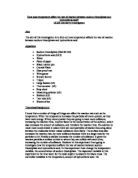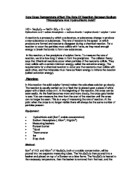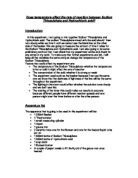Method
To start off this experiment I did a preliminary experiment, with my method shown below:
- Set up the equipment as shown in the diagram
- Measure 205cm3 of sodium thiosulhate out into a beaker
- Measure 305cm3 if water out into another beaker
- Measure 55cm3 of Hydrochloric acid into another beaker
- Next I will measure out 20cm3 from the beaker of thiosulphate, using a measuring cylinder, and then I will pour this into a test tube.
- I will then measure out 30cm3 from the beaker of water, using another measuring cylinder, then I will pour this into anther test tube
- I will place these two test tubes into the large beaker of water, sitting on the wire gauze, which was on top of the Bunsen burner, which was on top of the heatproof mat.
- I then placed a thermometer in each test tube and heated it up to the required temperature
- I will draw a black cross, with the marker pen, onto the piece of paper.
- I will measure out 5cm3 of hydrochloric acid, using a measuring cylinder, while the water and Sodiumthiosulphate is being heated.
- Once heated to the required temperature I will pour the thiosulphate, and the water into the conical flask, using a pair of tongs, which is placed on top of the cross
- I will then add the 5cm3 of Hydrochloric acid into the conical flask.
- Once I have done this I will press the stop clock
- When I can no longer see the black cross I will stop the stop clock and record the time.
- I will repeat this for all five reading, and then do repeats of the five readings.
- When taking a reading at 5 degrees I will place the two test tubes with water and sodium thiosulphate in a beaker of water, and ice cubes, so it can reach the required temperature.
Preliminary
Before I carried out the experiment I did a preliminary experiment, to test if the experiment would work.
Here were the results of my preliminary experiment
I used:
-
30cm3 Na2S2O3
-
20cm3 H2O
- 5cm3 HCL
In the table above it is clear that as the temperature increases so does the time it takes to obscure the black cross, meaning the reaction time also increase as the temperature increase. On my second reading at 30(0C) I didn’t get a time. This is because I pressed the wrong button on the stop clock, causing it to reset, not giving me a reading. This means in the real experiment I must pay more care and attention. Each reading happens quite quickly, in less than 80 seconds. In the actual experiment I will use a less concentrated solution, to slow down the reaction time. I will do this by instead of using 30cm3 of Na2S2O3 I will use20cm3. I will still use 5cm3 of HCL, and finally instead of using 20cm3 of H2O I will use 30cm3. The volume for this experiment, which was 55cm3 was fine, and caused no problems, so I will keep the volume the same for the real experiment.
For the real experiment I will take 5 readings, and a repeat for each. I will take a reading at the following degrees, going up in 15: 5, 20, 35, 50, and 65.
Fair test
In order for my findings to be valid the experiment must be a fair one. I will use the same person each time for judging when the X has disappeared. If we were to change who the observer was then we might not get an accurate reading, as our eyesight’s could be of different quality. I will also make sure that the same observer is used for reading the temperature of the thermometer, who will read it at eye level each time, to get an accurate reading.
I will make sure that the measuring cylinders, and beakers with the HCl, sodium thiosulphate, and water will not be mixed up, by putting on labels to say what they are. will not be mixed up. The amount of HCl will be 5 cm3 each time, the amount of thiosulphate will be fixed at 20cm3, and the amount of water will be 39cm3. I will make sure each time I take a reading I will use the exact same volume, and again measure at eye level.
I also will wear goggles and an overall, in case of spillages. I will keep the surfaces clear, and tie up my hair.
Also, to make it a fair test I will use the same black cross each time, being careful not to get it wet. Otherwise it would have a different intensity, and might become easier or harder to obscure.
A pair of goggles will be worn during the heating part of the experiment in order to protect the eyes. An overall will also be worn to protect the skin and clothing. When handling hot beakers and measuring cylinders a pair of tongs will be used. A gauze and heatproof mat will be used while heating to avoid any damage to the equipment.
During the heating stage of the experiment, a blue flame will be used throughout. Also the same Bunsen burner and gas tap will be used to maintain continuity. All of these precautions will make my final results more reliable and keep anomalies at a minimum so therefore make the entire investigation more successful.
I also made sure that I started the stop clock the moment the Hydrochloric acid had been all poured into the solution each time.
I also kept the variables the same. I kept the independant variable the same, which was the concentration of sodium thiosulphate, and I kept the controlled variables the same, the amount of HCL (concentration and volume).
A final thing I did was wash out my beaker, each time it had been used, so no HCL was remaining in there from the previous reading, therefore not speeding up the reaction time of my next reading.
Results
I used:
-
20cm3 Na2S2O3
-
30cm3 H2O
- 5cm3 HCL
Below are my results
On the following page is my graph to show my results.
Conclusion
From the graph and table of results it is clear that as the temperature increases so does the rate of reaction. This is because when the particles are heated it means the have more energy. By giving the particles extra energy they will move faster. This means that they cover more ground and are therefore more likely to hit each other, or have a collision, which in turn makes the reaction faster.
This is because when the temperature increases so does the average energy of particles, therefore the number of particles which have the activation energy increases. Therefore the proportion of collisions which occur at activation energy also increases. The more collisions there are then the faster a reaction is going to occur, making the solution turn cloudy and making the X disappear.
My results support the prediction I made because in my prediction I said ‘as the temperature is increased the rate of reaction will increase.' I believe I was correct as doing the experiment states that the reaction time will be faster with a higher temperature because for a reaction to take place the particles need to collide with enough velocity so that they react. As the temperature is increased the particles move faster since they have more energy. This means that they are colliding more often and more of the collisions have enough velocity to cause a reaction. Since there are more collisions the chemical reaction takes place faster.
Evaluation
I think I have collected enough evidence to come to a correct conclusion. I feel this experiment has gone well. Nothing went wrong and no anomalies can be found on the graph, and they all matched my prediction. This is because I took care when taking the readings, and measuring the volumes, and carrying out the experiment. I also made sure the experiment was a fair test. I am sure of my conclusion as all of the points lie on the line of best fit When taking reading one, and two at 35°C, each time the cross was obscured after 76seconds, to (2sf). This makes me confident that I carried out the procedure accurately, and that the results are reliable. If you look at my graph, at the lowest temperature of 5°C the reaction rate was slow at 0.004(S ) per second. Then if you u look at the highest temperature of 65°C the reaction took place much quicker, at 0.056(S ) per second.
Additional work, which could be carried out, is to repeat the experiment using, a wider range of temperatures. I could see what happens when the solution is cooled to minus figures. The investigation could also be extended to investigate other factors affecting the rate of reaction such as catalysts, concentration, surface area and catalysts. I could also change the controlled variables, such as the total volume of the experiment, or the amount of Hydrochloric acid.
To improve this investigation I could carry it out using a slightly different method, measuring how much light passes through the mixture, using a light sensor. Graphs will then appear on the computer of light level against time show exactly
how quickly the reactions occurred. I would do this by placing a light sensor underneath the solution. This solution could be held on top of a wire gauze, which can be held on top of a tripod. I will then place a light source above. This would be a very accurate way, and you would be able to see exactly how quickly the reaction takes place, to the second. This would account for any human error when timing, of poor human eyesight. Another way I could improve this experiment is to heat up the Hydrochloric acid (HCl) at the same time. This would make the overall temperature of the solution the same temperature, which I wanted. However when I didn’t heat it, it meant the HCL, which was at room temperature would have cooled the solution down slightly. A final thing I could do to improve my investigation is heat the sodiumthiosulphte, and the water together in the same test tube. Once the solution has reached its required temperature then we could pour it into the beaker straight away then add the HCL, as apposed to poring the water and the sodiumthiosulphate in separately. This would mean I could add the HCl to the solution quicker, and therefore prevent cooling of the solution, before the reaction takes place.
I feel this experiment went well. I kept it a fair test, and each time I took a reading at different temperature I kept the other variables the same.






